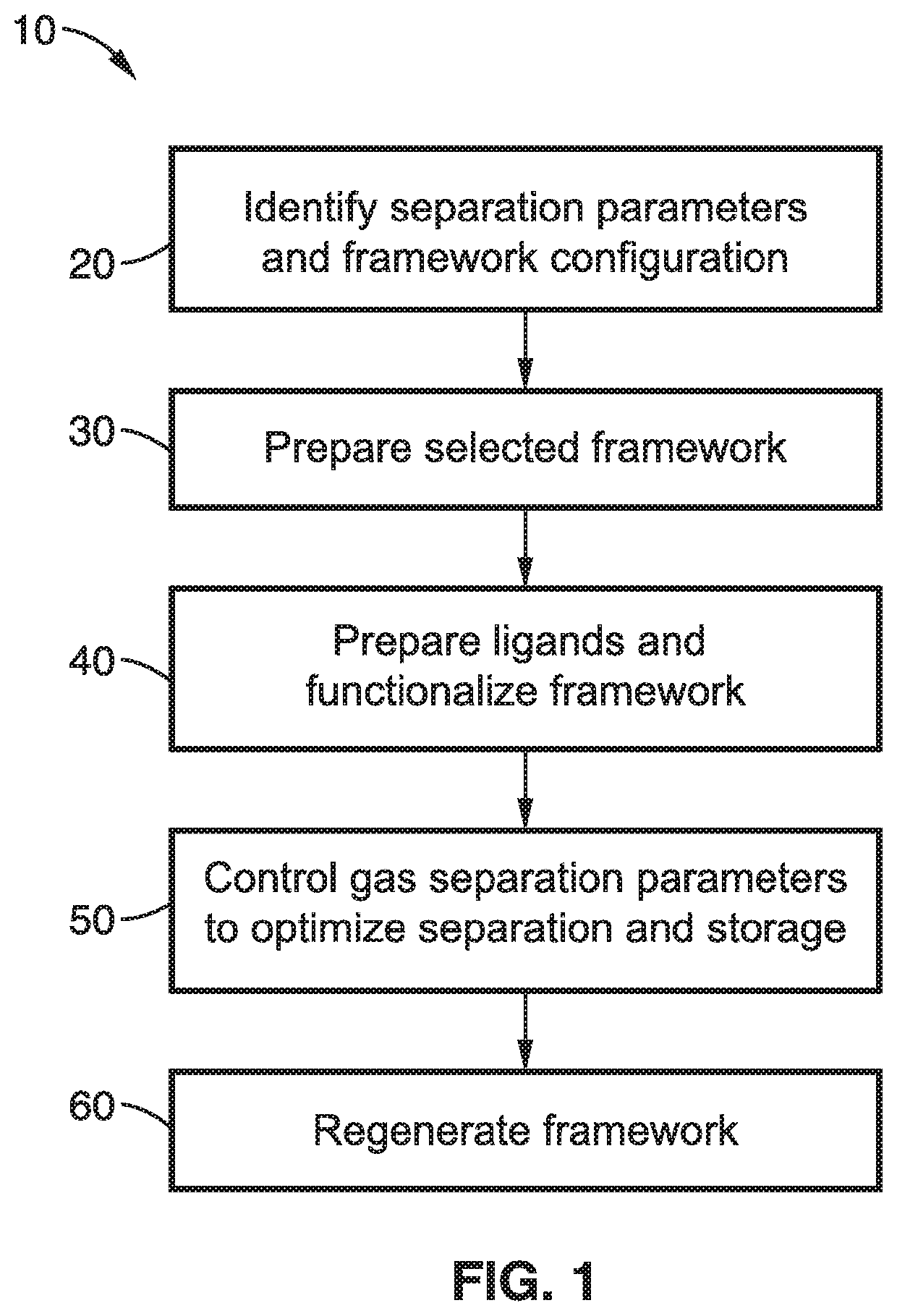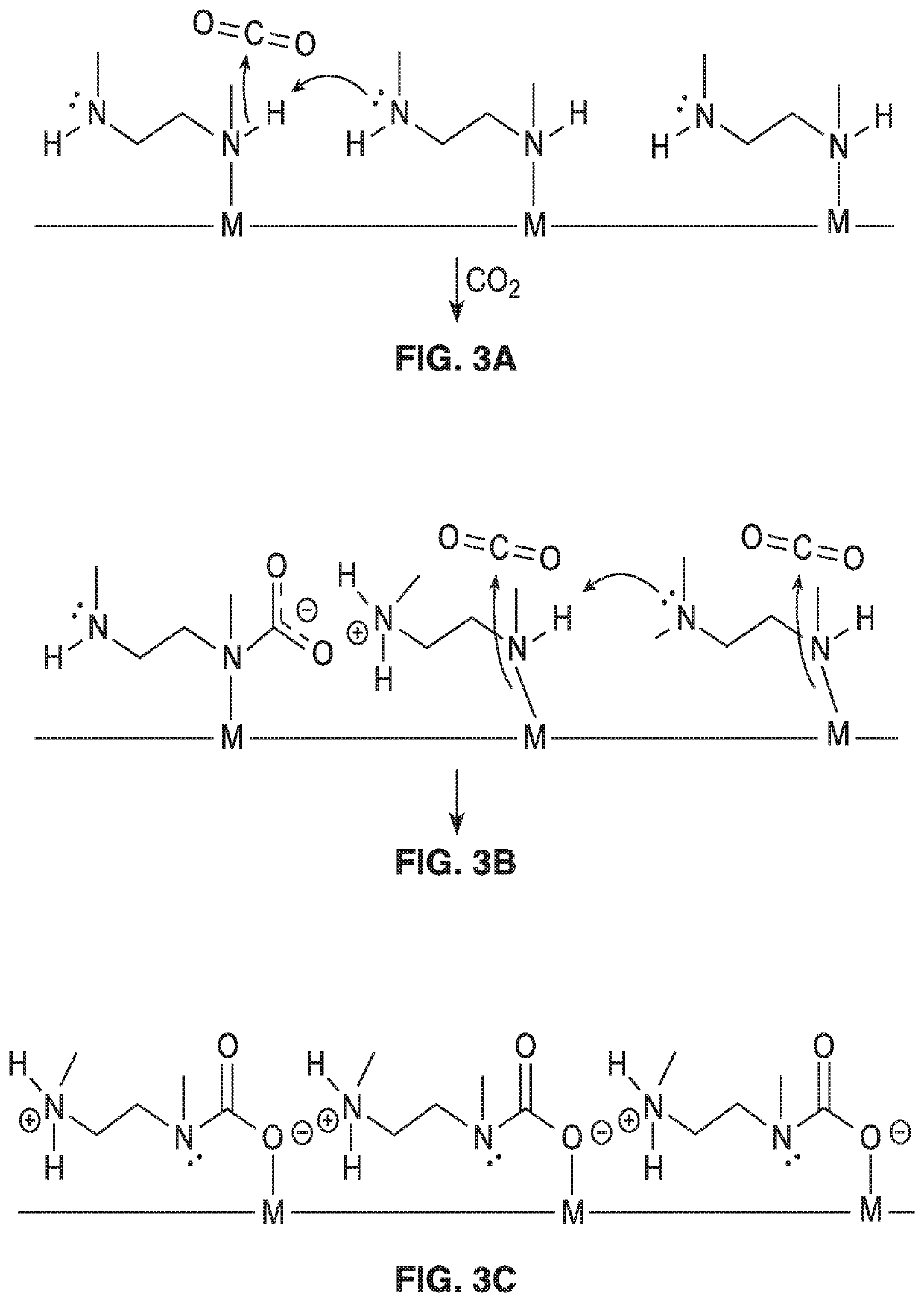Cooperative chemical adsorption of acid gases in functionalized metal-organic frameworks
a technology of acid gas and functionalized metals, which is applied in the direction of separation processes, physical/chemical process catalysts, and other chemical processes, can solve the problems of weakening or breaking of the bond between different components of the adsorbent, and achieve the effects of increasing heat transfer from the adsorbent to the cooling fluid, reducing costs, and reducing the temperature of regeneration
- Summary
- Abstract
- Description
- Claims
- Application Information
AI Technical Summary
Benefits of technology
Problems solved by technology
Method used
Image
Examples
example 1
[0103]In order to demonstrate the technology, several diamine-appended metal-organic frameworks (mmen-M2(dobpdc) (mmen=N,N′-dimethylethylenediamine; M=Mg, Mn, Fe, Co, Zn; dobpdc4−=4,4′-dioxidobiphenyl-3,3′-dicarboxylate) were produced and tested.
[0104]All reagents and solvents were obtained from commercial sources at reagent grade purity or higher. A 10% v / v stock solution of N,N′-dimethylethylenediamine (mmen) in hexanes was used for amine functionalization reactions. The mmen solution was stored under N2 and was kept free of H2O contamination by the inclusion of freshly ground CaH2 in the 200 mL Schlenk flask. The compound H4(dobpdc) was synthesized using conventional methods.
[0105]For the synthesis of Mg2(dobpdc), H4dobpdc (27.4 mg, 0.10 mmol) was added to a 20-ml glass scintillation vial and Mg(NO3)2.6 H2O (64.0 mg, 0.25 mmol), and 10 ml of mixed solvent (55:45 MeOH:DMF) were subsequently added. The vial was sealed with a PTFE-lined cap and placed in a 2 cm deep well plate on a ...
example 2
[0108]To further demonstrate the operational principles of the methods, spectroscopic and diffraction measurements were undertaken to determine the mechanism of CO2 uptake leading to a steep adsorption step for adsorbents such as mmen-Mg2(dobpdc). In particular, powder X-ray diffraction studies, which were performed on the isostructural compound mmen-Mn2(dobpdc) due to the greater crystallinity of its base framework, provided detailed structural information on how CO2 binds within the channels of the material. Diffraction data collected at 100K before and after exposure of a sample to 5 mbar of CO2 showed the unit cell volume contracting by just 1.112(8)%, but revealed large changes in the relative intensity of selected diffraction peaks.
[0109]Complete structural models were developed for both data sets using the simulated annealing method, as implemented in TOPAS-Academic, followed by Rietveld refinement against the data. Before exposure to CO2, the mmen molecules were bound throug...
example 3
[0112]The mechanism of CO2 adsorption suggests that variation of the metal amine bond strength should provide a method of manipulating the isotherm step position. The CO2 adsorption isotherms series of the mmen-M2(dobpdc)(M=Mg, Mn, Fe, Co, Ni, Zn) compounds were measured at 25, 40, 50 and 75° C. With the exception of the Ni compound, which showed normal Langmuir-type adsorption behavior, all of the materials showed sharp isotherm steps that shifted to higher pressure with increasing temperature. Analysis of the isotherm steps at 25° C. yielded Hill coefficients of 10.6, 5.6, 7.5, 11.5 and 6.0 for M=Mg, Mn, Fe, Co and Zn, respectively, reflecting the cooperative nature of the CO2 adsorption mechanism.
[0113]For a given temperature, the step position varies in the order Mg
PUM
| Property | Measurement | Unit |
|---|---|---|
| temperatures | aaaaa | aaaaa |
| pressures | aaaaa | aaaaa |
| pressures | aaaaa | aaaaa |
Abstract
Description
Claims
Application Information
 Login to View More
Login to View More - R&D
- Intellectual Property
- Life Sciences
- Materials
- Tech Scout
- Unparalleled Data Quality
- Higher Quality Content
- 60% Fewer Hallucinations
Browse by: Latest US Patents, China's latest patents, Technical Efficacy Thesaurus, Application Domain, Technology Topic, Popular Technical Reports.
© 2025 PatSnap. All rights reserved.Legal|Privacy policy|Modern Slavery Act Transparency Statement|Sitemap|About US| Contact US: help@patsnap.com



